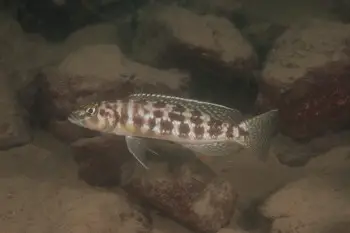Predatory cichlid from Lake Tanganyika described
A new species of the piscivorous cichlid genus Lepidiolamprologus is described in the journal ‘Zootaxa’ this week.
L. kamambae (Kullander, Karlsson, & Karlsson 2012) is currently known only from Kamamba and Kerenge islands, located just off the Tanzanian coast in the southern part of the lake, but may also occur around nearby Mwila and Nkondwe islands.
It was observed to inhabit the so-called ‘transition zone’ at around 15 m depth, where rocky shoreline habitats begin to give way to more open, sandier substrates with scattered rocks. Its relatively pale colour pattern is well-suited to these surroundings and it was initially considered to be a light-coloured phenotype of the congener L. kendalli which has an overall darker colour pattern and hunts prey in rocky biotopes with caves and crevices.
It’s particularly similar to four other members of the genus collectively referred to as the L. elongatus ‘group’, comprising L. elongatus (Boulenger 1898), L. mimicus (Schelly, Takahashi, Bills, & Hori 2007), L. kendalli (Poll & Stewart 1977), and L. profundicola. L. nkambae (Staeck 1978), a fifth species which would formerly have been included in this group, is synonymised with L. kendalli in the new study.
Among these L. kamambae appears most closely-related to L. elongatus, L. kendalli, and L. mimicus since these share a colour pattern comprising three horizontal rows of dark blotches on each flank but it can be distinguished from all three by presence of a broad, dark stripe on each cheek.
In addition, it can be told apart from L. profundicola by possessing a row of dark blotches along the middle of each flank (this character has been reported unvouchered specimens of L. profundicola), lacking cheek scales except for a few posterodorsally (vs. numerous rows of regularly-arranged scales on cheeks), possessing more lateral scales (64–71 vs. 61–65), and presence (vs. absence) of dark markings on the cheeks and dorsum of the head.
Following Schelly (2007) the only other species in the genus is L. attenuatus which is easily identified since it possesses only two rows of dark flank blotches (of which the median is particularly prominent and others often obscure) and lacks a frontal pattern of light spots on a dark background.
For more information please refer to the full, open access paper: Kullander, S. O., M. Karlsson, and M. Karlsson. 2012. Lepidiolamprologus kamambae, a new species of cichlid fish (Teleostei: Cichlidae) from Lake Tanganyika. Zootaxa 3492: 30-48
Category: Ichthyology, New Species, News | Tags: cichlid, Kullander, lamprologin, Lepidiolamprologus, Tanganyika | Comment »





Site improvements
thanks
21st Jan 2025
Site improvements
This is an excellent post, glad you shared it. I just stumbled upon your blog and have enjoyed reading your posts.
14th Jan 2025
Site improvements
This is an excellent post, glad you shared it.
14th Jan 2025
Product reviewers wanted
Are you still looking for product reviewers?
19th Dec 2024
Product reviewers wanted
Hey! Interesting article!
17th Dec 2024